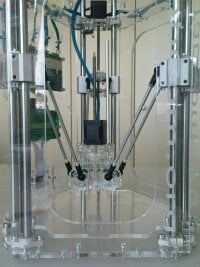
Invisible 3D printer emissions can sometimes be toxic
I’ve become aware of a potential issue that some readers may not know about: PFTE toxicity.
PTFE is a very common component used in filament-based 3D printers. It’s the white material used in tubes guiding filament towards the extruder and hot end. Bowden-style 3D printers require the use of PTFE tubes to ensure the extruder can push the filament properly, but direct extruders do not require such tubes.
Hot End Design
However, there is still PTFE in your 3D printer: it’s hidden in the hot end structure.
Most hot end systems actually employ a short PTFE tube inside the hot end to guide the filament towards the “hot” zone of the hot end. (“Hot ends” are actually composed of hot and cold zones, separated by a “heatbreak”.)
The reason for this small tube is that PTFE is actually a very slippery substance, and it ensures the filament can smoothly make its way down the final millimeters to the hot zone. Most times 3D printer operators don’t even notice this component, as it is inside the hot end.
Occasionally though, heavy use or overly-high temperature may deform the tube and it may require replacement. I’ve replaced several in my equipment over the years.
What Is PTFE?
PTFE is an acronym for Polytetrafluoroethylene, a synthetic polymer first made in 1938. It’s actually a family of polymers, and perhaps the most notable made to date is DuPont’s famous Teflon. That’s the substance that makes your frying pan non-stick — PTFE is slippery, remember?
Is PTFE Toxic?
PTFE is normally not toxic at all. In fact, you probably just ate some sausages fried on a Teflon surface, demonstrating PTFE’s non-toxicity.
However, a problem occurs when PTFE is inadvertently heated. At certain temperatures, heated PTFE can begin to emit rather severe neurotoxins. How bad can they be? One study from 2003 claimed these emissions actually kill birds!
What is emitted? It seems that beginning at 200C, PTFE begins to emit toxins, which increase in amount and type as the temperature rises. One source I read indicated that at 500C+ octafluoroisobutylene gas was emitted. This gas is apparently 10X as toxic as phosgene, a gas used in WWI during chemical attacks. Multiple studies seem to indicate plenty of bad effects from PTFE off-gassing due to high temperature.
PTFE in 3D Printer Hot Ends
At this point you might be wondering why PTFE is used at all in 3D printer hot ends: why would you put a material that is toxic at high temperatures near a heat source?
It turns out that normally the PTFE tube is not actually exposed to the heat, as it is located in the cold zone of the hot end. There it normally does not reach temperatures anywhere near 200C.
Two Types of Hot Ends
But there is a scenario that can cause problems, and it relates to the two types of hot ends typically available today: regular and “all metal”.
![Regular hot end on the left, all-metal on the right [ Image courtesy of Kodak ]](https://fabbaloo.com/wp-content/uploads/2020/05/hot-end-types_img_5eb065d01ad9e.jpg)
Regular hot end on the left, all-metal on the right [Image courtesy of Kodak]
See the diagram here of the typical two types of hot end designs. In a regular hot end, the PTFE tube is placed relatively close to the hot nozzle. This is required for “soft” materials such as PLA, which has a low heat deflection temperature, and especially for flexible filaments, which act like wet spaghetti and require guidance through the entire path.
On the other hand, an all-metal hot end has the PTFE tube physically separated from the hot zone by some distance. The materials used in an all-metal hot end are more rigid and don’t require quite the same guidance as the floppy materials.
Why have two kinds of hot ends? Why not just use a regular hot end design? The reason is that the all-metal hot end is capable of heating to much higher temperatures as required by certain materials. When the all-metal hot end gets very hot, the PTFE is still safely far away.
Toxic 3D Printing
This is where the problem lies: if a regular hot end is heated to higher temperatures, there is a risk that the PTFE will be raised above 200C where emissions commence.
That is normally not an issue because the materials intended to be 3D printed on regular hot ends require relatively low temperatures. However, the problem occurs when 3D printer operators try to 3D print high-temperature materials on regular hot ends.
Perhaps someone has been using PLA and ABS for a while, and wants to 3D print some unusual material that requires, say, 255C, or 270C. If they do not have an all-metal hot end, they could risk neurotoxin emissions from the PTFE. There is usually nothing physically preventing this from happening; a 3D printer operator can load any filament into the machine, and set any target temperature.
It is possible that regular hot ends are by chance designed in a way to minimize this effect, but how do you know without disassembling the hot end? Most people would not do that, and some would not know how.
My concern is that there are probably many unknowing 3D printer operators silently poisoning themselves and nearby living organisms by improperly attempting to 3D print high-temperature materials.
There are definitely 3D printers available that offer all-metal hot ends, and those in the know should choose them if 3D printing higher-temperature materials. One machine I’ve been using, the Kodak Portrait, actually includes both types in one machine, which is quite handy when 3D printing a variety of materials.
My advice: Identify what kind of hot end your device includes, and only use appropriate materials.

